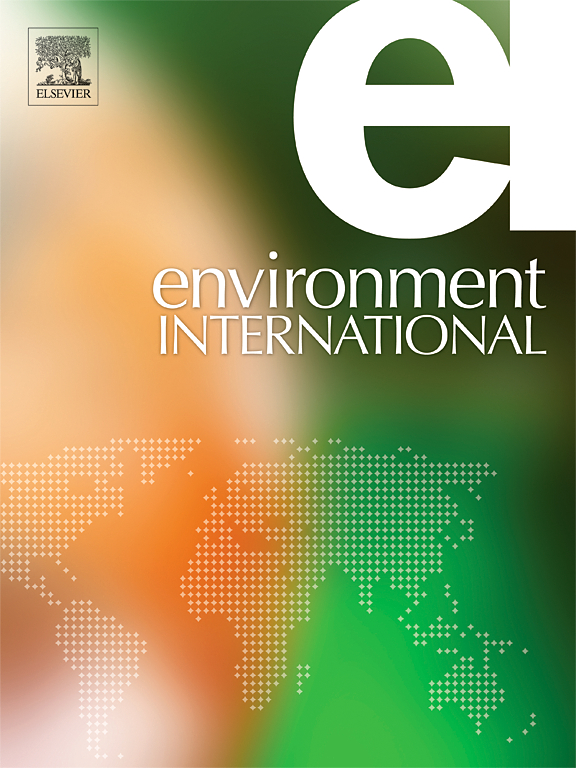Quantitative reconstruction of long-term spatiotemporal patterns of high-resolution ground-level NO2 concentrations in mainland China using fusion techniques and a machine learning framework
IF 10.3
1区 环境科学与生态学
Q1 ENVIRONMENTAL SCIENCES
引用次数: 0
Abstract
Nitrogen dioxide (NO2), as a critical trace gas, plays multiple roles in the atmosphere and poses potential threats to human health. However, existing satellite monitoring methods face challenges, including limited satellite mission durations, poor data quality, and low spatial resolution, which hinder the ability to provide long-term, high-precision NO2 information. To address these issues, this study uses the TROPOMI tropospheric NO2 column concentration product as a baseline and employs partition and cumulative distribution function (CDF) techniques to generate a satellite fusion dataset with both long time spans and high consistency. Based on this dataset, a high-performance, high-spatial-resolution long-term surface NO2 estimation model was developed using machine learning algorithms combined with multi-source geographic data. The model successfully estimates daily average near-surface NO2 concentrations (1 km2 resolution) for mainland China from 2014 to 2020. The results show that the proposed fusion method effectively integrates OMI and TROPOMI data, improves the spatial correlation between satellite products by 16.2 % (R = 0.74 → 0.86), significantly enhances the spatial coverage, and thus more accurately characterizes the spatial distribution characteristics of NO2. The surface-level NO2 estimates based on the LGBM model achieved an R2 of 0.85 in ten-fold cross-validation, with corresponding root mean square error (RMSE) and mean absolute error (MAE) of 7.51 µg/m3 and 5.22 µg/m3, respectively, demonstrating good extrapolation ability for temporal variations. The long-time series results accurately reflect the temporal and spatial evolution of NO2 in mainland China, while the high-precision estimates provide detailed pollution exposure information, revealing urban-scale pollution differences and seasonal variations.
基于融合技术和机器学习框架的中国大陆高分辨率地面NO2浓度长期时空格局定量重建
二氧化氮(NO2)作为一种重要的微量气体,在大气中发挥着多种作用,对人类健康构成潜在威胁。然而,现有的卫星监测方法面临挑战,包括卫星任务持续时间有限,数据质量差,空间分辨率低,阻碍了提供长期,高精度NO2信息的能力。为了解决这些问题,本研究以TROPOMI对流层NO2柱浓度乘积为基线,采用分区和累积分布函数(CDF)技术生成了长时间跨度、高一致性的卫星融合数据集。在此基础上,利用机器学习算法结合多源地理数据,建立了高性能、高空间分辨率的地表NO2长期估算模型。该模式成功估算了2014 - 2020年中国大陆近地表NO2日平均浓度(1 km2分辨率)。结果表明,所提出的融合方法有效地整合了OMI和TROPOMI数据,将卫星产品之间的空间相关性提高了16.2 % (R = 0.74 → 0.86),显著提高了空间覆盖率,从而更准确地表征了NO2的空间分布特征。在十倍交叉验证中,基于LGBM模型估算的地表NO2的R2为0.85,相应的均方根误差(RMSE)和平均绝对误差(MAE)分别为7.51 µg/m3和5.22 µg/m3,显示出良好的时间变化外推能力。长时间序列结果准确反映了中国大陆NO2的时空演变,而高精度估算提供了详细的污染暴露信息,揭示了城市尺度的污染差异和季节变化。
本文章由计算机程序翻译,如有差异,请以英文原文为准。
求助全文
约1分钟内获得全文
求助全文
来源期刊

Environment International
环境科学-环境科学
CiteScore
21.90
自引率
3.40%
发文量
734
审稿时长
2.8 months
期刊介绍:
Environmental Health publishes manuscripts focusing on critical aspects of environmental and occupational medicine, including studies in toxicology and epidemiology, to illuminate the human health implications of exposure to environmental hazards. The journal adopts an open-access model and practices open peer review.
It caters to scientists and practitioners across all environmental science domains, directly or indirectly impacting human health and well-being. With a commitment to enhancing the prevention of environmentally-related health risks, Environmental Health serves as a public health journal for the community and scientists engaged in matters of public health significance concerning the environment.
 求助内容:
求助内容: 应助结果提醒方式:
应助结果提醒方式:


